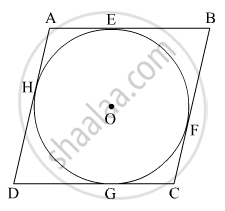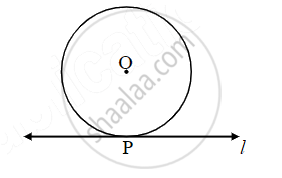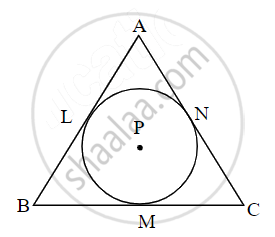Advertisements
Advertisements
प्रश्न
Four alternative answers for the following question is given. Choose the correct alternative.
A circle touches all sides of a parallelogram. So the parallelogram must be a, ______
विकल्प
rectangle
rhombus
square
trapezium
उत्तर
ABCD is a parallelogram. A circle with centre O touches the parallelogram at E, F, G and H.
ABCD is a parallelogram.
∴ AB = CD .....(1) (Opposite sides of parallelogram are equal)
AD = BC .....(2) (Opposite sides of parallelogram are equal)
Tangent segments drawn from an external point to a circle are congruent.
AE = AH .....(3)
DG = DH .....(4)
BE = BF .....(5)
CG = CF .....(6)
Adding (3), (4), (5) and (6), we get
AE + BE + CG + DG = AH + DH + BF + CF
⇒ AB + CD = AD + BC .....(7)
From (1), (2) and (7), we ahve
2AB = 2BC
⇒ AB = BC .....(8)
From (1), (2) and (8), we have
AB = BC = CD = AD
∴ Parallelogram ABCD is a rhombus. (A rhombus is a parallelogram with all sides equal)
Hence, the correct answer is rhombus .
संबंधित प्रश्न
If two circles with radii 8 cm and 3 cm, respectively, touch internally, then find the distance between their centers.
If two circles with radii 8 cm and 3 cm respectively touch externally, then find the distance between their centres.
Two circles having radii 3.5 cm and 4.8 cm touch each other internally. Find the distance between their centres.
In the given figure, the circles with centres P and Q touch each other at R. A line passing through R meets the circles at A and B respectively. Prove that – (1) seg AP || seg BQ,
(2) ∆APR ~ ∆RQB, and
(3) Find ∠ RQB if ∠ PAR = 35°
In the given figure, ray PQ touches the circle at point Q. PQ = 12, PR = 8, find PS and RS.
Four alternative answers for the following question is given. Choose the correct alternative.
Two circles of radii 5.5 cm and 3.3 cm respectively touch each other. What is the distance between their centers ?
Four alternative answers for the following question is given. Choose the correct alternative.
Chords AB and CD of a circle intersect inside the circle at point E. If AE = 5.6, EB = 10, CE = 8, find ED.
Line l touches a circle with centre O at point P. If radius of the circle is 9 cm, answer the following.
- What is d(O, P) = ? Why?
- If d(O, Q) = 8 cm, where does the point Q lie?
- If d(O, Q) = 15 cm, How many locations of point Q are line on line l? At what distance will each of them be from point P?

Draw circles with centres A, B and C each of radius 3 cm, such that each circle touches the other two circles.
Two circles of radii 5.5 cm and 3.3 cm respectively touch each other externally. What is the distance between their centres?
Four alternative answers for the following question is given. Choose the correct alternative.
Two circles having diameters 8 cm and 6 cm touch each other internally. Find the distance between their centres.
Line ℓ touches a circle with centre O at point P. If radius of the circle is 9 cm, answer the following.

What is d(O, P) =? Why?
Line ℓ touches a circle with center O at point P. If the radius of the circle is 9 cm, answer the following.

If d(O, Q) = 8 cm, where does the point Q lie?
Line ℓ touches a circle with centre O at point P. If radius of the circle is 9 cm, answer the following.

If d(O, R) = 15 cm, how many locations of point R are line on line l? At what distance will each of them be from point P?
A circle with centre P is inscribed in the ∆ABC. Side AB, side BC, and side AC touch the circle at points L, M, and N respectively. The radius of the circle is r.

Prove that: A(ΔABC) = `1/2` (AB + BC + AC) × r
Two circles of radii 5.5 cm and 4.2 cm touch each other externally. Find the distance between their centres.
